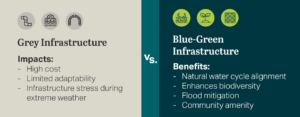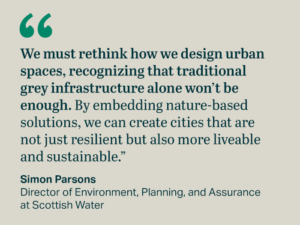Rethinking water infrastructure: a new era of resilient and sustainable solutions
Two fundamental questions shape every major infrastructure project: Can we afford to build it? And can we afford to operate it? As climate change intensifies and urban populations grow, conventional solutions to water management are becoming less viable — both economically and environmentally. The challenge now is not just about managing existing systems but rethinking infrastructure from the ground up.
Across Australia, New Zealand and beyond, water resilience is at the heart of urban sustainability. The increasing frequency of extreme weather events, coupled with aging infrastructure, means we need to adopt new approaches to managing stormwater, reducing sewage overflows and creating livable, green cities.
The transition from grey infrastructure — concrete pipes, tunnels and treatment plants — to integrated blue-green solutions is no longer optional; it’s a necessity.
The wake-up call: Lessons from extreme weather events
Events like Tropical Cyclone Alfred in South East Queensland demonstrated the challenges posed by climate variability. Heavy rainfall and subsequent flooding placed significant pressure on existing infrastructure, reinforcing the importance of integrating nature-based solutions to enhance resilience and mitigate future risks. As extreme weather events become more frequent, the urgency to build more resilient communities continues to grow.

The shift to blue-green infrastructure
Cities around the world are beginning to embrace blue-green infrastructure — nature-based solutions that work with, rather than against, the water cycle. These projects aim to slow, store and treat water naturally, reducing the burden on traditional sewer systems while delivering multiple co-benefits.
We integrate wetlands, mangroves and green infrastructure into urban and rural landscapes to protect water, support biodiversity and enhance climate resilience. By working with nature, we ensure that communities across ANZ benefit from sustainable, adaptive and long-term water solutions that safeguard both people and the environment.
Learning from global leaders in water resilience
From our work around the world, there are three key lessons that can be applied to Australia and New Zealand:
- Proactive investments pay off – The Glasgow Smart Canal demonstrates how digital technology, integrated with blue-green infrastructure, can anticipate and manage heavy rainfall. By lowering canal levels in advance of storms, the system provides much-needed storage capacity to reduce flood risks and enable urban development.
- Nature can be our greatest asset – The Mansfield sustainable drainage project in the U.K. proves that working with nature—through rain gardens, bio-swales, and permeable paving—can prevent sewer overflows while enhancing urban livability.
- Collaboration Is Key – Northern Ireland’s approach to wastewater treatment in wetlands highlights the power of cross-sector collaboration. By engaging local communities and stakeholders, water utilities can create solutions that are both environmentally effective and socially beneficial.
The call for cross-sector collaboration
The success of these projects’ hinges on collaboration. Water utilities, urban planners, landscape architects, ecologists and engineers must work together to break down silos and integrate water-sensitive designs into future developments. Public engagement is also critical — when communities see the tangible benefits of blue-green spaces, they become advocates for further investment in sustainable infrastructure.
As Cathy Crawley, our ANZ nature-based solutions lead, explains:
“Nature provides the best solutions. By integrating blue-green infrastructure into our urban and rural landscapes, we’re not only protecting water but enhancing biodiversity, supporting community well-being, and increasing climate resilience. Our challenge is to work with nature, not against it, to deliver infrastructure that safeguards both people and the environment.”
Additionally, Simon Parsons, director of environment, planning and assurance at Scottish Water, highlights the importance of long-term thinking:
“We must rethink how we design urban spaces, recognizing that traditional grey infrastructure alone won’t be enough. By embedding nature-based solutions, we can create cities that are not just resilient but also more liveable and sustainable.”
The future of water resilience
The transition from grey to blue-green infrastructure represents a paradigm shift in urban water management. By embracing nature-based solutions, cities can build resilience against climate change, reduce operational costs and enhance quality of life for their residents.
The challenge ahead is not just technical — it’s about leadership, collaboration and a willingness to rethink traditional approaches. The need for change is clear, and the opportunity is immense.
Listen to the accompanying podcast here.







